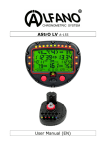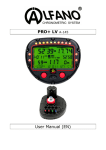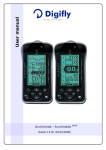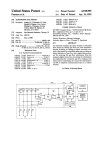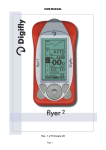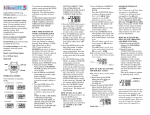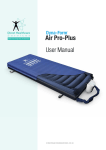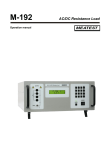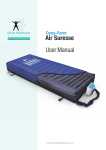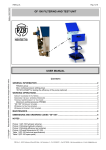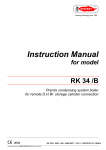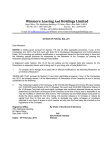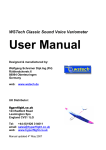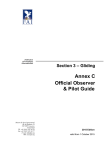Download USER MANUAL
Transcript
USER MANUAL 1 VL300 FIGURE 1 FIGURE 2 2 USER MANUAL TABLE OF CONTENTS 1 VL300 GENERAL DESCRIPTION 1.0 Power on 1.1 Contrast Setting 1.2 Main Graphic Variometer 1.3 Sound Variometer 1.4 Average Variometer 1.5 Voltmeter 1.6 Watchdog 1.7 Battery Timer 1.8 Date Indicator 1.9 Screen Number Indicator 1.10 Data Entry 1.11 Polar Recorder 1.12 Maximum Efficency Speed Indicator 2 DESCRIPTION OF PROGRAMMABLE INSTRUMENTS AREA 2.0 2.1 2.2 2.3 2.4 2.5 2.6 2.7 2.8 Description of Programmable Instruments Graphic Altimeter Altimeter A1 Altimeters A2 / A3 Clock / Timer Barometer / Thermometer Anemometer Numerical Variometer Efficiency Indicator 3 DESCRIPTION OF FUNCTION MENU 3.0 Retrieval of Function Menu 3.1 Start 3.2 Set Altimeters 3.3 Set Barograph 3.4 Set Variometers 3.5 Set Timer 3.6 Set Screens 3.7 Moviola 3.8 Diagnostics 3.9 Agenda 3.10 Pilot Data 3.11 Printer and PC 4 TECHNICAL DATA 4.0 Serial Interface 4.1 General Technical Data 3 VL300 1 VL300 GENERAL DESCRIPTION 1.0 Power on Turn on with the special switch. (FIG. 2 - POS. 13) Your VL300 will execute a self-check lasting about two seconds, and will then be ready for flight. The main instruments are displayed. 1.1 Contrast Setting The display contrast can only be adjusted using keys and , if the "START" function and average variometer (FIG. 2 - POS. K) have been selected. 1.2 Main Graphic Variometer The main graphic variometer (FIG. 2 - POS. F) normally displays a +5m/sec to -5m/ sec scale. Higher values can also be shown thanks to automatic change over to a 10 m/sec scale, providing both numerical and graphic representations (bars go totally dark). 1.3 Sound Variometer The sound variometer gives out sound signals the frequency of which changes in accordance with main graphic variometer values. Ascent sounds are very different from descent sounds: during ascent, the sound is frequency-modulated with intermittent variable pulse trains, while during descent the sound is only frequency-modulated. The sound volume can be adjusted to three different levels using key : off, medium and high. The volume level is indicated by a flashing circle in the display bottom line: empty circle = off; half full circle = medium; full circle = high. Sound ascent and descent thresholds can be set separately (see 3.4). 1.4 Average Variometer The average variometer (FIG. 2 - POS. K) has the same technical specifications as the main variometer, except for vertical speed reading, which is in this case an average value, calculated on the basis of the latest readings (the number of which can be programmed). It is therefore particularly useful for you to understand if you are doing better or worse. 1.5 Voltmeter The voltmeter shows the battery voltage (FIG. 2 - POS. G). This voltage should never be lower than 7.5 Volts: if this is the case, an alarm message is displayed by the VL300 to prevent instruments from reading incorrect values. 1.6 Watchdog The watchdog is a monitoring device constantly checking VL300 built-in microcom puter sound operation. A flashing circle (FIG. 2 POS. H) indicates that everything is 4 USER MANUAL in order. 1.7 Battery Timer The battery timer indicates the VL300 operating range hours left (FIG. 2 - POS. I). WARNING! This timer should be reset whenever the battery is recharged (see 3.5). 1.8 Date Indicator The date indicator (FIG. 2 POS. L) displays the current date using the day/month/year format. 1.9 Screen Number Indicator The screen number indicator shows which one of the three programmable instrument screens is being used (FIG. 2 POS. M). 1.10 Data Entry The data recorder is a VL300 built-in device allowing the following data to be stored: pilot name, aircraft type, takeoff date and time, landing time, 3600 barographic points and minimum and maximum values reached. The 3600 barograph points are used to store altimeter A1 readings every n seconds (1 to 30 second intervals can be selected) up to a total recording time of 30 hours. Minimum and maximum values are those recorded by altimeter A1, by the anemom eter, variometer and thermometer. The data recorder is started by depressing keys and one after the other and can be turned off either using key and or automatically - at the end of the maximum recording time. When the data recorder is on, the letter “R” (FIG. 2 POS. N) WARNING! Whenever a new recording is started, the old data is erased. Important data should therefore be printed or transferred into a personal computer. 1.11 Polar Recorder 1) Select "SET BAROGRAPH". 2) Select choise "5) POLAR". 3) Set 1=POLAR (0=NORMAL). 4) Record data flying in quite air; instead of letter "R" (FIG. 2 - POS. N) will appear letter "P". 5) Using moviola function you can review polar data; at the bottom of display, for each point, you can see respectively vertical speed (v), orizontal speed (o), indicated air speed (i) and efficiency. 1.12 Maximum Efficiency Speed Indicator To select the maximum efficiency speed indicator push the key ; instead of average variometer it will appear the maximum efficiency indicator. (fly trying to keep the graphic bar in the center of graphic scale). This indicator uses a polar curve given by three parameters (KA, KB,KC); these 5 VL300 parameters must be set depending on wing type. To set the parameters value you have to: 1) Select "SET BAROGRAPH". 2) Select choise "4 SET K POLAR". 3) Give for each parameter (KA, KB, KC) integer value and decimal value. During the flight it is possible to set wind speed; this value is shown at the bottom of and maximum efficiency speed indicator and it can be changed with the keys by steps of 5 Km/h. (NOTE: the keys and have this function only if it is selected the maximum efficiency speed indicator - see 1.1). 2 DESCRIPTION OF PROGRAMMABLE INTRUMENTS AREA 2.0 Description of Programmable Instruments The instruments described hereabove are located in a fixed screen area which cannot be modified. Another series of instruments can be positioned at will in one of the five special areas in the right part of the screen (with the exception of the graphic altimeter, which needs to be positioned in the first two top right areas). (FIG. 2 - POS. A/B/C/D/E) By simply depressing key , you can select one of the 3 five-instrument screens. The instruments which can be located in each of the 3 mentioned screens are described in detail herebelow (see 3.6). 2.1 Graphic Altimeter It graphically displays flight progress using altimeter A1 readings. To enter values on the X-axis (Sec) and on the Y-axis (m) see 3.3. 2.2 Altimeter A1 Altimeter A1 shows the altitude in m; it has a -300 to +9000 m range and 1 m resolution. It can be set both in m and in mB (see 3.2). 2.3 Altimeters A2 / A3 Altimeters A2 and A3 have the same characteristics as altimeter A1, but they can also be reset by simply pressing key . If used in this way, they can also be two practical indicators of altitude gain or loss. Selection of altimeter 2 or 3 is done by depressing key . 2.4 Clock / Timer The double-acting clock / timer instrument can show either the current hour/minutes or the number of minutes which have elapsed after power on. Selection of clock or timer is done by depressing key . 6 USER MANUAL 2.5 Barometer / Thermometer The double-acting barometer / thermometer instrument can show either the atmos pheric pressure (range: 1050 to 300 mB; resolution: 1 mB) or the VL300 internal temperature (range: -40 to +90 C degrees; resolution: 0.5 C degrees). Selection of barometer or thermometer is done by depressing key . 2.6 Anemometer The anemometer shows airspeed in km/h with a range from 0 to 120 km/h and a resolution of 1 km/h. 2.7 Numerical Variometer The numerical variometer shows vertical speed with a range from +13 m/sec to -13 m/sec and a resolution of 10 cm. 2.8 Efficiency Indicator The Efficiency Indicator instrument shows wing's istantaneous efficiency during flight, calculating the informations given by anemometer, variometer and wind speed. The last one can be modified during flight; this value is shown at the bottom of maximum efficiency speed indicator and it can be changed with the keys and by steps of 5 Km/h.(NOTE: the keys and have this function only if it is selected the maximum efficiency speed indicator - see 1.1). 3 DESCRIPTION OF FUNCTION MENU 3.0 Retrieval of Function Menu The general menu of functions can be retrieved at any time by simply depressing key . Select by moving the cursor to the desired function using the special keys or , then enter your choice with key . A description of the available functions is given here below: 3.1 Start By selecting function Start (1), you can control main screen instrument display. 3.2 Set Altimeters By selecting function Set Altimeters (2), you can set one of the three VL300 altimeters in two different ways, i.e. either in m or in mB. Setting an altimeter in meters means to enter the current altitude value in meters, while setting an altimeter in mB means entering the pressure of a point with respect to which you wish to find out the difference in height (meters). Setting altimeters in mB proves particularly useful during transfer flights and in all other situations when several aircrafts are flying together, and it is recommendable 7 VL300 that all altimeters be set to the same pressure (ex. 1013 mB). 3.3 Set Barograph Selection of the Set Barograph function (3) is done to carry out one of the following operations: 1) Set Sampling, to select the number of seconds bewtween one barograph sampling and another. 2) Set Window X, to select the number of seconds between one graphic altimeter updating and another. 3) Set Window Y, to select the value in meters of each point on the graphic altimeter Y-axis. 4) Set K Polar, to adjust the parameters to create the wing's polar curve. 5) Polar, to select the polar recorder. 3.4 Set Variometers Selection of the Set Variometers function (4) is done to carry out one of the following operations 1) Set Inertia to enter a main variometer inertia time value in accordance with current weather conditions: if weather conditions are weak, use low inertia values to make the most of the weakest ascent flows; if weather conditions are strong, use high inertia values to tell true ascent flows from mere turbulence. 2) Set Ascent Threshold to enter an ascent value threshold beyond which the sound signal is heard. 3) Set Descent Threshold to enter a descent value threshold beyond which the sound signal is heard. 4) Set Variometer Average to enter a delay for the calculation of average vertical speed. 3.5 Set Timer Selection of the Set Timer function (5) is necessary to execute one of the following operations: 1) Set Date (to enter today’s date) 2) Set Time (to enter current time) 3) Set Battery Timer to select autonomy time of NiCd rechargeable battery. Recharge the VL300 battery in the following way: make sure the VL300 is off and the battery charger is not powered. Plug the battery charger into the VL300 special outlet. Feed 220 Vac mains voltage to the battery charger, make sure the red LED is turned on; charging should last for about 13 hours. Disconnect the battery charger and perform function Set Battery Timer on your VL300. 3.6 Set Screens The Set Screens function (6) is used to choose the instruments to display on the three screens. Proceed as follows: a) select a screen to modify from the screen menu b) enter the desired instrument codes in the special areas shown by the flashing 8 USER MANUAL D/ cursor then press key . Any instrument combination can be entered, except for graphic altimeter (code 01) which must be located in the first two top right screen areas. (FIG. 2 - POS. A/B/C/ E). 3.7 Moviola The Moviola function (7) is the VL300 most innovating function as it allows all data concerning the latest recorded flight to be reviewed on the screen. The above data can be displayed in two ways: 1) Graphically -If you select this mode, your VL300 will first of all present the whole flight on its display, independently of flight length. Then you will be able to analyze every single screen point by simply pressing keys and . For each point in the graphical representation, altitude (in m) and absolute or relative time values will be shown. Use key to shift from absolute to relative time and vice versa. After moving the cursor to the graph point you wish to magnify, press key . When the ZOOM (magnification) is on, the following keys are also enabled: key moving the cursor backwards by one page, key moving the cursor forwards by one page, keysv and centering the graph in the screen, and key allowing ZOOM amplification parameters to be changed. There are two ZOOM amplification parameters: the range value to be displayed (in m) and the sampling time multiplying factor. To turn off the ZOOM depress key once more. To return to the previous menu, press key . 2) Minima and Maxima - If you select this mode, your VL300 will display a table containing data concerning the recorded flight, i.e. flight date, takeoff time, landing time and minimum and max. values reached. Minimum and maximum values are those recorded by altimeter A1, by the anemometer,variometer and thermometer. To return to the previous menu, press key . 3.8 Diagnostics Function Diagnostics (8) contains advanced tests and a few parametrizations and should therefore be used by DIGIFLY authorized technicians only. 3.9 Agenda Selection of the Agenda function (9) is used to display or modify a notebook containing six lines of maximum 18 alphanumeric characters each. 3.10 Pilot Data Function Pilot Data (10) is selected to change the aircraft or pilot names. These two data can contain letters, numbers and gaps up to a maximum of 10 characters each. 9 VL300 3.11 Printer and PC The Printer and PC function (11) is used to transfer data and information from the VL300 to peripherals in the following ways: 1) Flight Data Printing - Data concerning the latest recorded flight are sent to either a terminal emulation PC or a serial printer through a serial gate. 2) Graph Printing - The graphic representation of data concerning the latest recorded flight is sent to a graphic printer (type EPSON P-40 Serial) through a serial gate. 3) PC connection - VL300 data is sent to an MS-DOS personal computer. The VL300 is supplied with a floppy disk containing instructions for use and a special data processing program to enter in your PC. With this specially designed software,all recorded flights can be transferred, stored on a floppy disk and rerun. An electronic flight log book can be obtained in this way using a common diskette. 4 TECHNICAL DATA 4.0 Serial Interface The VL300 serial gate has been set using the following parame ters in accordance with specifications RS232C: 4800 BAUD 8 DATA BIT NO PARITY 2 STOP BIT. NB: ALWAYS PLUG CABLES IN WHEN THE EQUIPMENT IS OFF. 10 USER MANUAL 4.1 General Technical data ALL INSTRUMENTS HAVE BEEN BALANCED TO TEMPERATURE AND AIR DENSITY Graphic Altimeter Range -300 +9000 Mt Resolution 1 Mt X e Y Axis adjustable Altimeters A1 A2 A3 Range -300 +9000 Mt Resolution 1 Mt can be set in Mt or Mb Altitude gain / loss Range -9000 +9000 Mt Resolution 1 Mt Sound Variometer Range -13 +13 Mt/Sec Resolution 0,1 Mt/Sec Inertia adjustable Ascent threshold adjustable descent threshold adjustable -40 °C +90 °C 0,5 °C 30 hours adjustable -300 +9000 Mt 1 Mt and 1 Sec Efficientimeter Numeric Variometer Range -13 +13 Mt/Sec Resolution 0,1 Mt/Sec Inertia adjustable Thermometer Range Resolution Barograph Max time Frequency Range Resolution Maximum Efficiency Speed Indicator Average Variometer Autorange -10 +10 Mt/Sec Resolution 0,1 Mt/Sec Delay adjustable 0 120 Km/h 1 Km/h 300 1050 mB 1 mB Polar Recorder Graphic Variometer Autorange -10 +10 Mt/Sec Resolution 0,1 Mt/Sec Inertia adjustable Anemometer Range Resolution Barometer Range Resolution Date and Time Date Format Hour Format day / month / year hours / minutes Flight Timer Range Resolution 0 999 Minutes 1 Minute Volmeter Range Resolution 0 15 Volts 0,1 Volt Rechargeable Battery Type 8,4V NiCd Operating time 12 hours Recharging 12 hours Data Batteries Type Operating time 2 X 3V Litium 10 years Dimensions 140 X 115 X 50 mm Total Weight 900 gr 11 VL300 FIGURE 3 12













